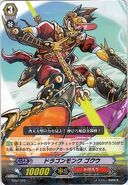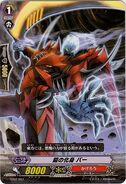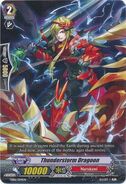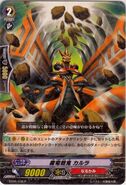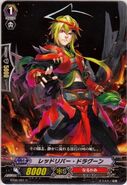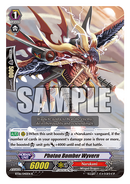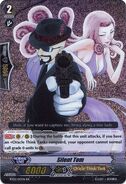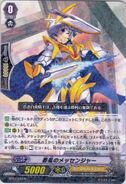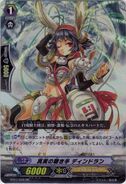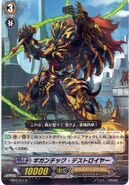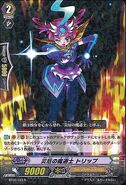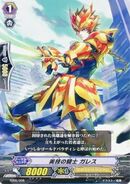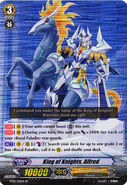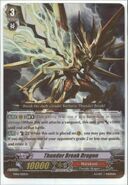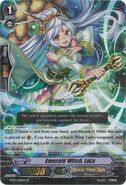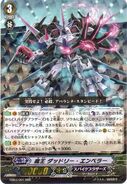The Magic Numbers
So.... what are they?
Magic Numbers are probably one of the quintessential points in learning the game. A huge chunk of Vanguard is based around hitting as hard as you can, also known as "beatsticking." Obviously, most units have their own individual skills that give Vanguard it's color, but other than that, Vanguard heavily relies on the numbers game.
Let me explain this from the very basics. You know how to guard, correct? When you want to guard, you choose units from your hand and/or units on your field that can intercept to guard against an attack. Well, here's an interesting thing to notice. Grade 0's have 10000 shield value, (except for Draw Triggers), Grade 1's and 2's have 5000 shield value, and Grade 3's have 0 shield value, and that's it. That's it.
So what does this mean? Well, it means this. Say you have a Grade 3 Vanguard with 10000 power (as most clans do). When you guard against attacks, you're only allowed to guard in intervals of 5000, with Grade 0's simply being 5000 doubled. So your intervals of guarding for your 10000 Vanguard are 15000, 20000, 25000, 30000...and so on. Now, if we take into account the rule that if the attacking unit's power is equal to the target's power the attack will hit, then we can create intervals such as this.
10000 Power
--- 20k
- 19k
- 18k
- 17k
- 16k
--- 15k
- 14k
- 13k
- 12k
- 11k
--- 10k
So with this graph illustrating it, we can say that if my opponent attacks for 10k, 11k, 12k, 13k, or 14k, we would need a 5k shield in order to block it. If my opponent attacks for 15k, 16k, 17k, 18k, or 19k, we would need a 10k shield to block the attack, and so on and so forth.
Well, in a roundabout way, this means that a 10k attack is just as powerful as a 14k attack. And a 15k attack is just as powerful as a 19k attack. How can that be? Well, both attacks require to the same shield to guard the attack. 10k requires a 5k shield, 14k requires a 5k shield. 15k requires a 10k shield, 19k requires a 10k shield, too. So yeah, in this case, a 10k attack is just as powerful as a 14k attack.
I feel the need to explain this because I've seen people I play against do some stupid things such as this. The field will be like this.
And they'll have this in their hand.
And they'll replace Jarran and put Bahr behind Goku, because they think it's a more powerful attack, when in reality it's not.
That leads to the unveiling of the "magic" numbers. I'll bring down that interval scale for you to look at again.
10000 Power
--- 20k
- 19k
- 18k
- 17k
- 16k
--- 15k
- 14k
- 13k
- 12k
- 11k
--- 10k
So, what are the magic numbers? Well, if the extra indenting behind those 3 numbers didn't tip you off, then I should tell you now that those are the magic numbers. So what's so magical about them? Well, these numbers are the benchmarks that you use to set up your columns to force out the most shield. They're the numbers you "aim" to hit. If you remember my example for setting up columns in Vol. 1, that's a perfect example of setting columns up to hit magic numbers.
So, to water it all down for you, if your opponent has a 10k Vanguard, what are the magic numbers? 15k, 20k, 25k and so on, right. Now what about an 11k Vanguard?
11000 Power
---21k
-20k
-19k
-18k
-17k
---16k
-15k
-14k
-13k
-12k
---11k
The numbers change by just +1k, but that +1k makes all the difference in the world. Now 10k vanilla G2's can't even hit them without booster or trigger support. They're the reason why people run the G3's that gain +2k when they attack. That simple increase in magic numbers from 10k, 15k, 20k to 11k, 16k, 21k is literally what shapes the competitive scheme of Vanguard and dictates what units people choose to put within their decks. With the existence of 11k's, competitive players pick units that set up 16k columns, just to hit that magic number. The 15k column that used to force 10k shield against 10k Vanguards now forces only 5k against 11k Vanguards.
And now for Crossrides...
13000 Power
---23k
-22k
-21k
-20k
-19k
---18k
-17k
-16k
-15k
-14k
---13k
This is what really broke the game. The bar was raised once again by the existence of G3's that gain +2k ON BOTH PLAYERS TURNS when they have a specific unit in the soul. Remember all that hubbub I was making about a simple increase in 1k power? Think about the noise when you take that increase and increase it again by +2k. Now the magic number people are looking at is 18k. But to attain that, that requires a 10k and 8k booster, which is very difficult to consistently make. It's pretty insane.
Finally, I'll talk about magic numbers for rear guards. Yes, rear guards have magic numbers just like every unit does, and it's important to not ignore them. Here let me give you an example.
Okay, if anybody has played against Oracle Think Tank for an extended period of time, they should know how annoying and deadly Silent Tom is, and if you leave him untouched, the unnecessary damage he does to you could be too much to come back from. Now, look at this situation. You're hitting good numbers against the Vanguard Wiseman, 15k with Garuda, and 18k with Thunderstorm. So let's say you attack Wiseman with Garuda, he doesn't guard, and neither player gets any triggers. Now it's Thunderstorm's turn to attack, but what should you do? Should you go after Wiseman or Tom? Well, going after Wiseman really isn't a bad play if he doesn't guard, since more damage = closer to victory. But think about next turn, when he rides to Grade 3 and gets his Twin Drive. If he gets a Critical Trigger, (assuming you don't guard) that's 2 damage to you already, and unless you have a Perfect Guard, that 21k Tom column is giving you a 3rd damage just like that. So really what you should do is look at Tom's magic numbers.
---18k
-17k
-16k
-15k
-14k
---13k
-12k
-11k
-10k
-9k
---8k
Being an 8k is what gives Tom his weakness, being weak offensively and defensively. In this case, you're exploiting his defensive weakness, because your Thunderstorm column is hitting for 18k, hitting that magic number. So in this case, if you go after Tom with Thunderstorm, he'll either lose Tom, or waste 15k shield saving him, which is really a win-win for you.
Rear guards shouldn't be disregarded in terms of magic numbers. If you have that 18k or 19k column, it gives you more options to go after rear guards if they're bothering you or if your opponent damage checks a trigger.
Understanding those 5k increments in magic numbers will help you set up your columns more intelligently. Learn them as quickly as you can, as they're the hidden foundation of Vanguard.
Next Week - Fundamentals of Vanguard Vol. 3

